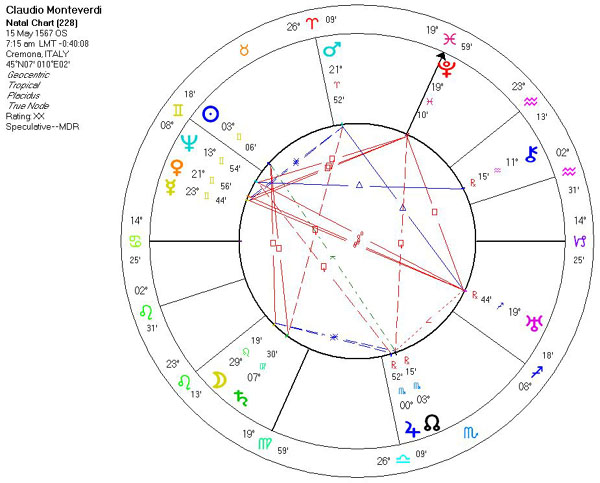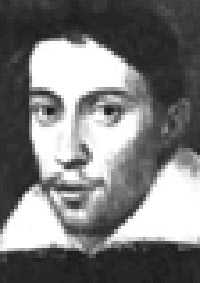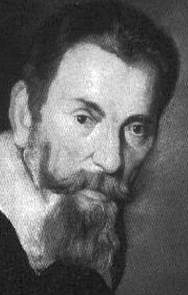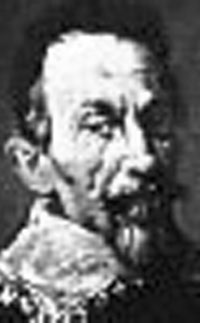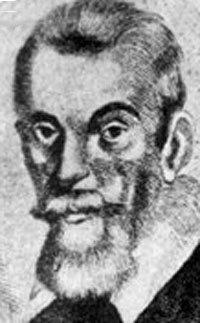Copyright Michael D. Robbins 2005
Astro-Rayological Interpretation & Charts
Quotes
Biography
Images and Physiognomic Interpretation
Music is spiritual. The music business is not.
The end of all good music is to affect the soul.
(Venus, Mercury & Neptune in Gemini opposition Uranus.)The modern composer builds upon the foundation of truth.
(Uranus in Sagittarius in 6th house.)
Monteverdi, Claudio (Giovanni Antonio) (b Cremona, 1567; d Venice, 1643). It.
Composer. Chorister, Cremona Cath.
At 16, when he was already a fine organist and viol player, he pubd. some sacred madrigals. Entered service of Duke of Mantua as viol player and singer of madrigals. Went with Duke on military expeditions to Danube and Flanders, 1595 and 1599. Heard and was influenced by Florentine operas of the Camerata, notably Peri's Euridice, 1600. His own first opera, La favola d'Orfeo was prod. in 1607, notable in history of mus. because for the first time the acc. was for a full (by the standards of the time) orch. The following year his Arianna was perf. at a ducal wedding celebration in Mantua; only the Lamento, which was immediately popular, survives.
He left Cremona after the death of the Duke in 1612 and in 1613 became Master of Mus. of the Venetian Republic. For St Mark's, Venice, he composed a superb stream of sacred works which spread his fame throughout Europe. He received a visit from Schütz and his works were studied by M. Praetorius in Ger., Mersenne in Fr., and Tomkins in Eng. 12 of the operas he had written in Mantua were destroyed there in 1630 when it was sacked by Austrian troops. In the same year the plague ravaged Venice; the combination of these catastrophes probably accounts for Monteverdi's admission to holy orders in 1632. When the first opera house, San Cassiano, was opened in Venice in 1637, Monteverdi's interest in opera was re-kindled and for the remaining 6 years of his life he comp. a series of works of which only 2 survive.
Monteverdi's place in the history of Renaissance mus. can be justly compared to Shakespeare's in literature. Working from traditional beginnings, he transformed every genre in which he worked by imaginative use of available styles rather than by revolutionary means. His madrigals cover a period of 40 years, from publication of the 1st book in 1589 to the 8th in 1638 (the 9th was pubd. posthumously in 1651). He soon introduced instr. accs., and chromatic modulations, and the dramatic nature of the mus. foreshadows the solo cantata and operatic recit., culminating in Il combattimento di Tancredi e Clorinda (1624) which is a miniature opera in style, acc. by str. and employing descriptive effects.
His sacred mus. veered between elaborate traditional polyphony and an advanced concerted style in which elements from his secular madrigals and operas lend colour and drama to the text, as in the famous Vespers comp. for Mantua in 1610. The operas take the Florentine melodramatic and monodic form and embellish it with all that he learned from It. madrigalists and Fr. composers. They are, in effect, the first mus. dramas, making use of what came to be known as leitmotiv and deploying many startling dramatic devices. They are also the first operas in which the characters are recognizably human rather than symbolic figures. Above all, the melodic genius and fertility of his mus. and its harmonic adventurousness are what make it so attractive and ‘contemporary’ in the 20th cent. Naturally, the scores present many musicological problems; their solution by various eds. has caused considerable disagreement among students of the period.
(Cremona, 1567 - Venezia, 1643)
The son of a doctor and the oldest of five children, he started to study music at a very early age under Marco Antonio Ingegneri, maestro di cappella at the cathedral in Cremona.When he was fifteen he gave proof of his exceptional talents publishing the Sacrae Cantiunculae for three voices, followed one year later by the Spiritual Madrigals for four voices and in 1584 by the Canzonette for three voices.
With the First Book of Madrigals (1587) he became famous throughout Europe and rightly won a place among the greatest European composers of the day.
In 1590 in Mantua he became a viol player and cantor in the music cappella of Duke Vincenzo Gonzaga. The duke was a lover of the arts and made his city into one of the most active centres of culture of the time. As part of the duke's retinue, he travelled to Hungary in 1595 for the campaign against the Turks and in 1599 went to Flanders.
Residence in the cultured, refined atmosphere of the Gonzaga court and these journeys gave him the opportunity to mature his artistic education and to enrich his experience through first-hand knowledge of different musical backgrounds which at the time were among the most active in Europe.
In 1595 he married the singer Claudia Cattaneo, who bore him three children. In the meantime, however, the duke's miserliness made his life difficult in economic terms. He was also embittered by the many enemies he had made as a supporter of progressive trends in music. The most blatant and harsh display of the polemics against him came in the pamphlet written by the Bolognese canon Giovanni Artusi - "L'Artusi overo delle imperfettioni della moderna musica" [Artusi or on the imperfections of modern music] - published in 1600.
Despite all this opposition Monteverdi's prestige continued to grow at the court of Mantua, both as a composer and as a concert master and director of music events; in 1602 the Duke Vincenzo appointed him 'maestro di musica', a position which was more honorary than financially rewarding.
In 1605 he finally decided to respond to his detractors in the highly polemical preface to the Fifth Book of Five-Part Madrigals, announcing a "seconda pratica overo perfettione nella moderna musica" [second manner or perfection in modern music].
His theatre debut came in 1607 when he staged "Orfeo", a fable in music which the duke had expressly requested to vie with the flamboyant spectacles of the court of Florence. Monteverdi's joy at the great success of his work was overshadowed by the death of his beloved wife, but news of his triumph spread quickly and Orfeo was performed in many cities in Italy.
Orfeo, created as an experiment, is a true landmark in the history of opera. Though it is based on the monodic mode already used by Jacopo Peri in 'Dafne' and by Giulio Caccini in his 'Euridice', in Monteverdi the "recitar cantando" [sung recitation] achieved prodigious development. Recitative style was perfected and appeared very varied, whilst the chorus and orchestra, which now began to represent a much more important group, accompanied singers for whom arias were scored; sinfonias and various instrumental pieces completed the work's musical structure. Moreover with the libretto by Alessandro Striggio junior, the composer drew an expressive, dramatic painting of rare intensity and great modernity.
This development that Monteverdi worked in theatre for music, which effectively came into existence through him, shaped the eminently operatic vocation that Italian music would adopt in the coming centuries.
Again in 1607 he wrote the musical Scherzos for three voices, and one year later an audience of thousands of people, exceptional in the period, followed the performance of his Arianna.
Il Ballo delle Ingrate was staged in 1608 and two years later he published in one volume an a cappella Mass for six voices and the splendid Vespro della Beata Vergine, dedicated to Pope Pius V.
On the death of Vincenzo Gonzaga, the composer abandoned the court of Mantua in 1613 and took on an enviable, and finally well-paid, lifetime post as "maestro di cappella to the Most Serene Republic of Venice".
He stayed in the lagoon city until his death, was considered by all one of the most illustrious living composers and was showered with honours. In this period he also proved to be a productive composer of sacred and religious works and continued to dedicate himself to madrigals and theatrical music as well. In particular he wrote in 1619 a Seventh Book of Madrigals for 1-4 and 6 voices, with other types of song entitled Concerto and an eighth, the famous "Madrigali guerrieri et amorosi" for various voices and instruments.
In 1632 Monteverdi, who had not remarried after the death of his wife, decided to take holy orders. In 1640 he wrote a miscellany of religious works, Selva morale e spirituale, the four-voice Mass and the Litanie della Beata Vergine, the two latter works published posthumously in 1650.
He also composed numerous dramatic operas which sadly have been lost. The only operas of the time that have come down to us are Il ritorno di Ulisse in patria, staged at the San Cassiano theatre in 1640 and the Incoronazione di Poppea, performed at the Teatro Santi Giovanni e Paolo in 1643, shortly before the composer died.
With this last opera Monteverdi introduced a genre that was to have great importance in music theatre, the opera on an historical subject, abandoning the subjects which had always been used previously based on imaginary characters from mythology.
Despite all this opposition Monteverdi's prestige continued to grow at the court of Mantua, both as a composer and as a concert master and director of music events; in 1602 the Duke Vincenzo appointed him 'maestro di musica', a position which was more honorary than financially rewarding.
In 1605 he finally decided to respond to his detractors in the highly polemical preface to the Fifth Book of Five-Part Madrigals, announcing a "seconda pratica overo perfettione nella moderna musica" [second manner or perfection in modern music].
His theatre debut came in 1607 when he staged "Orfeo", a fable in music which the duke had expressly requested to vie with the flamboyant spectacles of the court of Florence. Monteverdi's joy at the great success of his work was overshadowed by the death of his beloved wife, but news of his triumph spread quickly and Orfeo was performed in many cities in Italy.
Orfeo, created as an experiment, is a true landmark in the history of opera. Though it is based on the monodic mode already used by Jacopo Peri in 'Dafne' and by Giulio Caccini in his 'Euridice', in Monteverdi the "recitar cantando" [sung recitation] achieved prodigious development. Recitative style was perfected and appeared very varied, whilst the chorus and orchestra, which now began to represent a much more important group, accompanied singers for whom arias were scored; sinfonias and various instrumental pieces completed the work's musical structure. Moreover with the libretto by Alessandro Striggio junior, the composer drew an expressive, dramatic painting of rare intensity and great modernity.
This development that Monteverdi worked in theatre for music, which effectively came into existence through him, shaped the eminently operatic vocation that Italian music would adopt in the coming centuries.
Again in 1607 he wrote the musical Scherzos for three voices, and one year later an audience of thousands of people, exceptional in the period, followed the performance of his Arianna.
Il Ballo delle Ingrate was staged in 1608 and two years later he published in one volume an a cappella Mass for six voices and the splendid Vespro della Beata Vergine, dedicated to Pope Pius V.
On the death of Vincenzo Gonzaga, the composer abandoned the court of Mantua in 1613 and took on an enviable, and finally well-paid, lifetime post as "maestro di cappella to the Most Serene Republic of Venice".
He stayed in the lagoon city until his death, was considered by all one of the most illustrious living composers and was showered with honours. In this period he also proved to be a productive composer of sacred and religious works and continued to dedicate himself to madrigals and theatrical music as well. In particular he wrote in 1619 a Seventh Book of Madrigals for 1-4 and 6 voices, with other types of song entitled Concerto and an eighth, the famous "Madrigali guerrieri et amorosi" for various voices and instruments.
In 1632 Monteverdi, who had not remarried after the death of his wife, decided to take holy orders. In 1640 he wrote a miscellany of religious works, Selva morale e spirituale, the four-voice Mass and the Litanie della Beata Vergine, the two latter works published posthumously in 1650.
He also composed numerous dramatic operas which sadly have been lost. The only operas of the time that have come down to us are Il ritorno di Ulisse in patria, staged at the San Cassiano theatre in 1640 and the Incoronazione di Poppea, performed at the Teatro Santi Giovanni e Paolo in 1643, shortly before the composer died.
With this last opera Monteverdi introduced a genre that was to have great importance in music theatre, the opera on an historical subject, abandoning the subjects which had always been used previously based on imaginary characters from mythology.
Biography
He was born in Cremona in northern Italy. In childhood he studied with Marc Antonio Ingegneri, who was maestro di cappella at the cathedral in Cremona. Since there is no record of him singing in the cathedral choir, the music lessons must have been private. Monteverdi produced his first music for publication—some motets and sacred madrigals—in only 1582 and 1583, so he must have been something of a child prodigy. In 1587 he produced his first book of secular madrigals, and shortly thereafter began to look for work outside of his native town.In 1590 Monteverdi began working at the court in Mantua as a vocalist and viol player, and by 1602 he had become conductor there. Until his fortieth birthday he mainly worked on madrigals, composing nine books of them in all. Book V, published in 1605, was at the heart of the controversy between Monteverdi and Giovanni Artusi, where the latter attacked the "crudities" and "license" of the modern style of composing, centering his attacks on madrigals (including 'Cruda Amarilli', see Media, below) from the fifth book. Monteverdi made his reply in the introduction to the fifth book, with a proposal of the division of musical practice into two streams: what he called prima prattica, and seconda prattica: prima prattica being the previous polyphonic ideal of the sixteenth century, with flowing strict counterpoint, prepared dissonance, and equality of voices; and seconda prattica using much freer counterpoint with an increasing heirarchy of voices, emphasising soprano and bass. This represents an unconscious move towards the new style of monody. The introduction of a continuo instrumental part in many of the madrigals of the book is a further self-consciously modern feature. In addition, the fifth book showed the beginnings of conscious functional tonality. Book VIII, published in 1638, includes the so-called Madrigali dei guerrieri ed amorosi which many consider to be the perfection of the madrigal form. As a whole, the first eight books of madrigals show the enormous development from the Renaissance polyphonic music to the monodic style which is typical of Baroque music. The ninth book of madrigals, published posthumously in 1651, contains lighter pieces, such as canzonettas, probably composed throughout his lifetime and representing both styles.
From monody, with its emphasis on clear melodic lines, intelligible text and placid accompanying music, it was a logical step to begin composing opera, especially for a dramatically inclined composer who also loved grand effect. In 1607 he composed his first opera, Orfeo. It was common at that time for composers to create works on demand for special occasions, and this piece was meant to add some lustre to the annual carnival of Mantua. Indeed it was a great success, fitting very well in the spirit of the times. Orfeo is marked by its dramatic power and lively orchestration. Indeed, this piece is arguably the first example of a composer assigning specific instruments to parts, and it is also one of the first large compositions in which the exact instrumentation of the premiere has come down to us. The plot is described in vivid musical pictures and the melodies are linear and clear. With this opera Monteverdi had created an entirely new style of music, the dramma per musica (musical drama) as it was called. Monteverdi's operas are usually labelled "pre-baroque" or "early-baroque".
It is arguable that Monteverdi's greatest work remains the Vespro della Beata Vergine 1610 (The Vespers of the Blessed Virgin 1610). This is one of his few sacred works of any scale, but it remains to this day one of the greatest examples of devotional music, matched only by works such as Handel's Messiah and J. S. Bach's St. Matthew Passion. The scope of the work as a whole is breathtaking - each part (there are 25 in total) is fully developed in both a musical and dramatic sense - the instrumental textures are used to precise dramatic and emotional effect, in a way that had not been seen in before.
In 1613 Monteverdi was appointed as conductor at San Marco in Venice, where he soon revived the choir, which had withered under his predecessor. Here he also finished his sixth, seventh and eighth books of madrigals. The eighth is the largest, containing works written over a 30-year period, including the dramatic scene Tancredi e Clorinda (1624), in which the orchestra and voices form two separate entities. They act as counterparts. Most likely Monteverdi was inspired to try this arrangement because of the two opposite balconies in San Marco, which had inspired much similar music from composers there, such as Gabrieli. What made this composition also stand out is the first-time use of string tremolo (fast repetition of the same tone) and pizzicato (plucking strings with fingers) for special effect in dramatic scenes.
During the last years of his life Monteverdi became ill, but it did not keep him from composing his two last masterpieces, both operas: Il ritorno d'Ulisse in patria (1641), and the historic opera l'Incoronazione di Poppea (1642). L'Incoronazione especially is considered a culminating point of Monteverdi's work. It contains tragic as well as comic scenes, (a new development in opera), more realistic portrayal of the characters, and warmer melodies than had previously been heard. It requires a smaller orchestra, and has a less prominent role for the choir.
Monteverdi was ordained a Catholic priest in 1633. He died in Venice.
